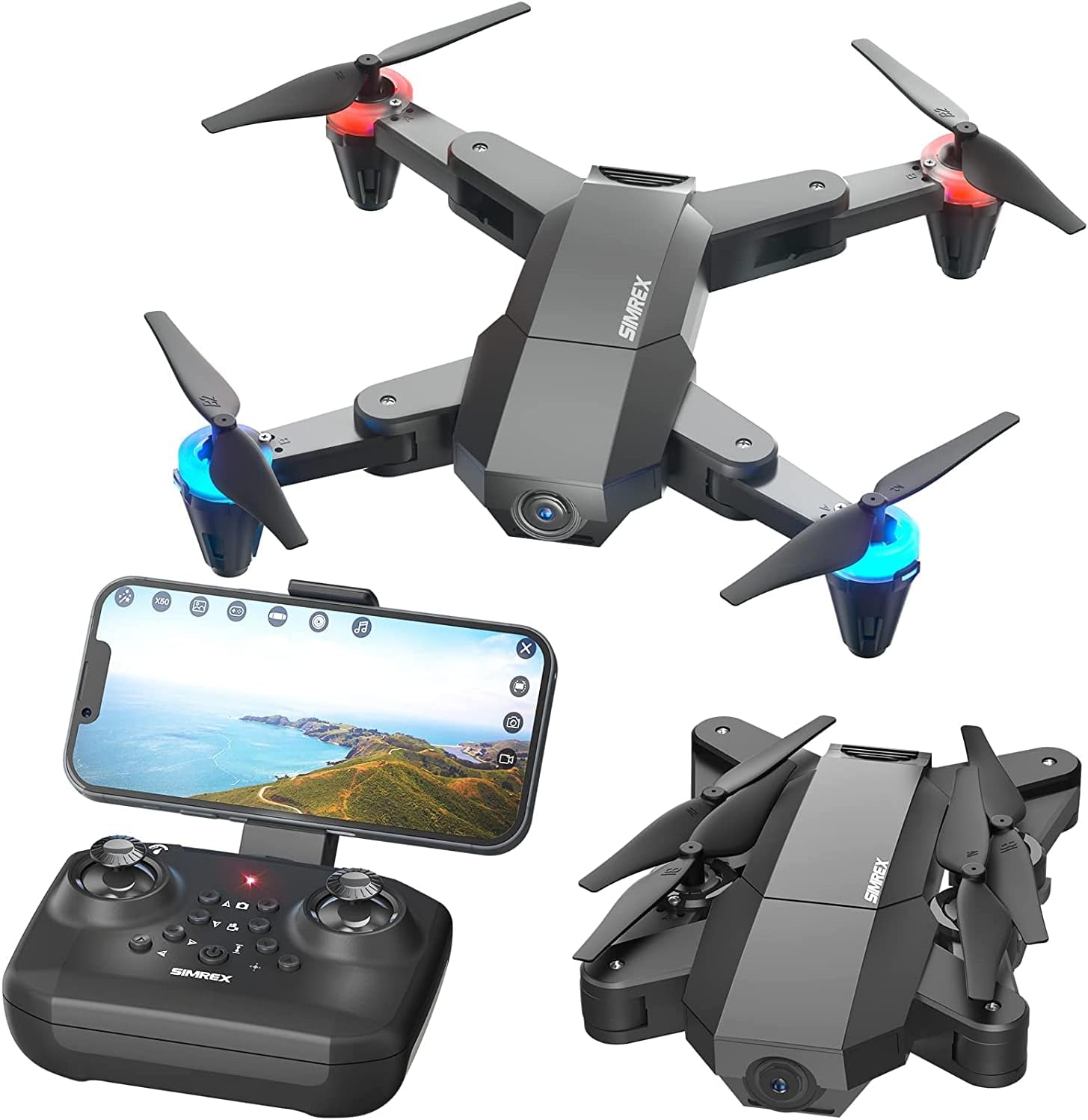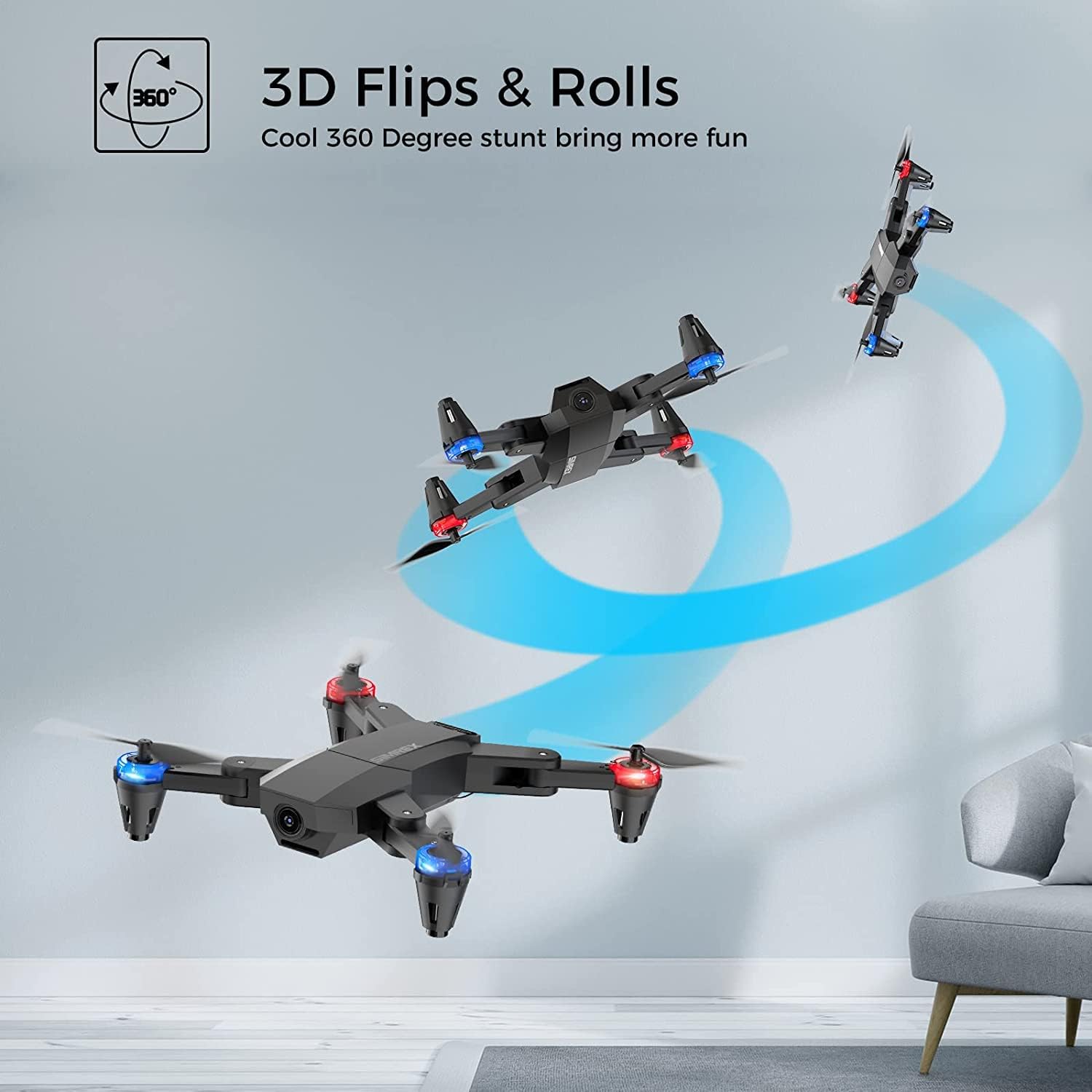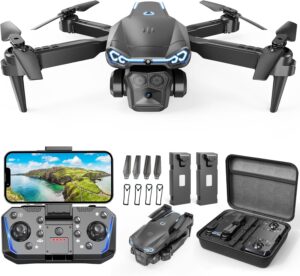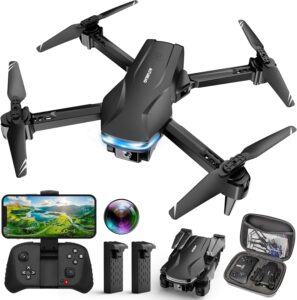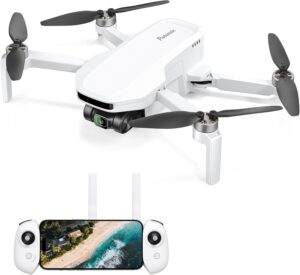Have we ever wanted to put a tiny helicopter in our bag, walk to the park, and feel briefly like responsible gods of a very small sky?
Who are we with a drone in our pocket?
We’re the sort of people who used to think drones were only for cinematic geniuses or neighbors who love aerial views of their roofs. Then we met the X500 mini Drone Optical Flow Positioning RC Quadcopter with 720P HD Camera, Altitude Hold Headless Mode, Foldable FPV Drones WiFi Live Video 3D Flips Easy Fly Steady for Learning Black, and realized maybe we just wanted something steady, friendly, and small enough to live in our lives without demanding more than a phone does. We hoped for a nimble flier, a simple camera, and the kind of stability that doesn’t require us to become amateur pilots overnight.
This drone promises Optical Flow Positioning, Altitude Hold, a foldable frame, 720P camera, WiFi FPV, and flips that make even us look like we know how to have a good time. We’ll tell you what worked, what didn’t, and how it turned our backyard into a makeshift airfield where nobody got hurt, not even the shrubs.
X500 mini Drone Optical Flow Positioning RC Quadcopter with 720P HD Camera, Altitude Hold Headless Mode, Foldable FPV Drones WiFi Live Video 3D Flips Easy Fly Steady for Learning Black
Unboxing the X500 mini Drone: small things, big intentions
There’s something pleasing about opening a box and not being assaulted by complicated parts, especially the kind that look like they belong in an orthopedic toolkit. The X500 wins this moment. We lift it out, and it’s compact even before we fold it. Folded, it measures roughly 110 by 80 by 35 mm, like a chunky wallet with propellers, which sounds worse than it is. In our hand, it felt light but not toy-flimsy. Like a travel gadget built for getting up, not growing up.
What’s in the box and what’s not
Inside, we got the drone, a controller, propeller guards, spare props, a battery, and the usual manners: a manual and a USB charging cable. The prop guards are optional but have a way of paying for themselves if we’re flying indoors near shelves, pets, or our own dignity. We’d love a carrying case, but it’s not promised in every kit, so we didn’t count on it.
There isn’t a microSD slot, because the X500 sends footage straight to our phone via WiFi. That means no onboard recording, and the quality of saved video depends on our phone and the strength of the WiFi FPV link. We quickly learned to stand close if we wanted smooth footage and fewer dropouts.
The fold and the finish
Folded, the X500 is friendly to pockets, purses, and glove compartments. Unfolded, the arms snap open with the assurance of a toy that knows its place. The black finish looks understated—no neon, no race stripes, just a miniature flyer doing its day job.
We wouldn’t call it rugged, but it did survive a few tumbles. The prop guards matter if we’re flying around furniture. Outdoors, they help, but wind is still the bigger adversary. More on that later, when our idealized flying dreams meet the breeze.
Setup: from couch pilots to backyard aviators
Setup is uncomplicated, which we appreciated because patience is a resource we burn faster than battery life. The X500 wants us to charge the battery, install the app (compatible with iOS and Android), unfold the drone, pair it, calibrate, and then feel brave.
Charging and battery life reality check
About that battery: the product details say a battery can support 8 to 12 minutes, and in another line, 10 to 13 minutes. In our hands, we saw about 9 to 11 minutes per charge with modest wind and casual hovering mixed with short forward flights. If we were doing flips, filming continuously, or trying to outfly the dog, we hit the lower end. Indoors, with minimal gusts and no aggressive maneuvering, we reached a hair over 11 minutes.
The best part about small batteries is we can charge them fast. The worst part is we want more of them. If we had two or three charged ahead of time, we could enjoy a proper outdoor session without feeling like the drone forgot our plans. We made a ritual of charging them in a clean, non-flammable area—because common sense is the true altitude hold.
Pairing and app: iOS/Android common sense
Pairing is straightforward: power on the drone, connect our phone to the drone’s WiFi network, open the app, and we’re allowed to see what the drone sees. We tried both iOS and Android; the FPV stream worked on both. The app gave us one-key takeoff and landing, a live feed, camera controls, and trim adjustments.
The latency on the WiFi video feed is noticeable, which is normal at this level. It’s fine for framing a shot and gentle flight; we wouldn’t try threading garden arbors from fifty feet away based on FPV alone. We kept the drone within line of sight, both for safety and for sanity.
Calibrations and safety
Having a slightly nerdy moment about calibration pays off. Before each flight, we made sure to:
- Place the X500 on a flat, level surface.
- Calibrate the gyro per the manual (usually stick or app command).
- Check propeller guards, battery seating, and that all arms were fully unfolded.
- Confirm we had enough room overhead—three meters at least indoors.
One-key takeoff and landing worked as advertised and gave us confidence. The emergency stop is the button we hoped never to use and were glad was there. We practiced it outdoors over grass, the soft landing pad of amateurs.
Flight performance: Optical Flow and Altitude Hold in real life
Optical Flow Positioning uses a downward-facing sensor to analyze the ground and help the drone stay put. Combined with Altitude Hold, the idea is to hover like a hummingbird with better manners. It actually worked surprisingly well indoors and over textured outdoor surfaces like grass or asphalt. Over uniform surfaces—shiny floors, reflective tiles, or monochrome rugs—the sensor had fewer cues and hovered with less precision.
Indoor hovering and Optical Flow nuances
Indoors, we were impressed. With no GPS, Optical Flow is about as good as it gets for a small drone trying to avoid acting like a Frisbee. In a living room under normal lighting, the X500 maintained position well enough for selfies and steady practice. It eased some of our anxiety, and we needed less counter-steering—not none, but less.
We noticed better performance with good, even lighting. If the floor pattern was too uniform or too glossy, the drone drifted a bit. No drama. Just a reminder to pick a textured surface, like a rug or wooden floor with visible grain, and we were golden.
Outdoor breezes and the reality of Altitude Hold
Altitude Hold kept the vertical position nicely. Wind, unfortunately, does not read manuals. In light breezes, the X500 kept its cool but drifted horizontally, especially when Optical Flow had trouble reading ground texture from higher altitudes. We learned to keep it low and nearby if the air moved like a curious cat.
The motor power is adequate for a mini drone, not athletic. We kept our outdoor flights modest: circles, gentle ascents, a flip or two to congratulate ourselves, and then brought it home. It’s not a storm chaser; it’s a fair-weather friend.
Headless Mode: training wheels for direction
Headless Mode was designed for that moment when we can’t remember which way the drone is facing, and our brain panics. With headless on, pushing the stick forward sends the drone away from us, backward pulls it back, and left-right remain left-right relative to us, not the drone’s nose. For beginners, it’s a relief. For us, too, if we were flying at twilight and our depth perception wandered off.
We consider Headless Mode training wheels. It’s helpful but shouldn’t become a crutch if we want to progress. The more we understood orientation, the more we used it sparingly.
Camera and FPV: 720P real-world expectations
The X500 promises a 720P HD camera and live video feed. The result is perfectly fine for social posts, quick clips, and remembering how astonishing it felt to see the backyard from twenty feet up. It isn’t cinematic, and we didn’t expect it to be.
Photo quality, color, dynamic range
Photos were decently sharp in the center with some softness at the edges. The color tended slightly warm, which made late-afternoon shots feel cozy. Dynamic range was limited; bright skies could blow out while shaded areas lost detail. We learned to angle the camera to include less sky and more earth, and suddenly everything looked more intentional.
We got the best results on bright, overcast days. Harsh sunlight simply asked more of the tiny sensor than it could give.
Video smoothness, frame rate, and latency
Video recorded to our phone sometimes stuttered if we flew out too far or turned through interference. Keeping the drone within 15 to 30 meters with a clear line of sight helped the FPV feed stay usable. We wouldn’t call it buttery, but for flyover shots of the patio, the dog’s procession, or a family picnic, it did the job.
Latency was noticeable; we didn’t try flying via FPV alone. Line of sight mattered. We flew the drone, and the FPV feed served as a helpful viewfinder.
Tricks and fun: the 3D flips that make us grin
The X500 has a dedicated 3D flips function that works like a party trick. Hit the flip command, push the direction, and it commits to a confident roll or flip. We liked saving flips for the end of a flight, mostly because they cost battery and sometimes made us so pleased we stopped paying attention.
If we enable flips indoors, we kept a healthy ceiling margin. Outdoors, we waited for still air. There’s no reason to stage a flip into a hedge.
Range, responsiveness, and control feel
The controller’s sticks are comfortable; the spring tension we’d call “light with intention.” We didn’t feel like we were gripping a video game controller from a forgotten console. It felt modern, if a bit minimalist.
Sticks, sensitivity, and rates
We got multiple speed rates—slow for learning, faster for open spaces. Slow mode felt right for hallways and living rooms. Fast mode made more sense outdoors, especially if we needed a modest burst to counter drift. The yaw rate (how quickly it turns) was reasonable without spinning us into vertigo.
Stick input translated predictably to movement. We had to adjust for tiny drift, which we expect on any non-GPS toy-class drone. Trim controls let us fine-tune yaw, roll, and pitch to counter drift or slightly crooked hover.
One-key takeoff/landing and emergency stop
One-key takeoff meant it rose to a safe height and waited for us, which is exactly the kind of chivalry we want in a flying object with blades. One-key landing brought it down slowly enough not to terrify the dog. The emergency stop is just that; it drops. We used it only when we risked hitting something that matters more than a prop. We practiced over grass just to understand the timing.
Portability: the art of being there when we need it
Foldable, lightweight, and about the size of a stack of coasters, the X500 encourages spontaneity. It goes in a small bag or jacket pocket and waits quietly. We took it on walks and became the people who say things like “Let’s do a quick shot from above,” as if this was normal human behavior. No case by default, so we used a soft pouch and some bubble wrap.
We liked that we weren’t lugging a case with spare landing gear and a thirty-page checklist. This drone wants to fly, not impress us with its demands.
Learning and teaching: for beginners and beyond
The X500 aims to be a learning drone, and it succeeds. Optical Flow Positioning and Altitude Hold lower the barrier to entry so first flights aren’t white-knuckled. Headless Mode keeps us in control when our spatial awareness takes a personal day. The 3D flips reward curiosity.
We used it as a stepping stone: learn orientation indoors, practice gentle arcs outdoors, try flips, then start framing simple shots. If we were teaching kids, we supervised closely and kept the guards on. Small drones are not toys in the stuffed-animal sense; they’re machines with whirring bits that deserve respect.
Reliability, durability, and our mildly embarrassing crashes
We didn’t crash on purpose, but we’re also not good at lying. It kissed a wall. It discovered the one sagging branch in the yard. It survived. The arms felt sturdy enough for the weight class. The prop guards prevented more damage than we want to admit. Post-tumble, we checked the propeller shafts and edges, replaced one bent prop, and recalibrated. Back in the air it went.
We’d rate durability as fair to good for a lightweight beginner drone. Don’t throw it, don’t fly it into the ceiling fan, and do give it a soft area to land if you’re practicing emergency stops.
Propellers, guards, and spares
Spare props are included, and we used one. Swapping them is easy if your fingers have patience. We kept a tiny screwdriver handy because life tends to put screws in the way of fun. If we planned to fly in tight spaces regularly, we kept the guards on. They add a little weight and catch on stuff less often than our pride.
The crashes we learned from
- Indoor lesson: don’t take off under a pendant lamp.
- Outdoor lesson: wind at face level is kinder than wind ten feet up.
- Camera lesson: avoid pointing at the sun like a moth with ambition.
- Battery lesson: land with a minute or two to spare; don’t run it to zero.
Battery management and charging safety
Lithium batteries are like house guests: they appreciate a little attention and hate being ignored for months. We charged them on a clean, non-flammable surface, never left them unattended for long, and avoided extreme temperatures. If we were storing them for more than a few weeks, we aimed for a partial charge instead of full or empty.
We also set realistic flight routines: two batteries, ten minutes each, with a water break for us while the drone cools. This kept the motors happy and the fun sustainable.
App features and privacy considerations
The app is straightforward: live view, capture buttons, some trim adjustments, and toggles for flips and speed. It asked for the usual permissions. We gave it only what it needed to function; no reason a drone app needs to read our grocery list. We didn’t see any alarming behavior, but we prefer to keep the app closed when we’re not flying. Call us cautious, or just people who like to sleep well.
Specs and features snapshot (and what they mean to us)
To keep things clear, we put the highlights into a simple table. It’s our way of confessing we like order, even when we pretend to be spontaneous.
| Feature | Manufacturer Claim | Our Notes |
|---|---|---|
| Camera | 720P HD | Good for casual photos and short clips; best in bright, even light. |
| FPV | WiFi Live Video to phone | Works within ~15–30 m with line of sight; some latency and occasional stutter. |
| Positioning | Optical Flow | Stable hover indoors and over textured surfaces; less effective on glossy/monotone floors or at higher altitudes outdoors. |
| Altitude Hold | Yes | Holds vertical position well; wind still affects horizontal drift. |
| Flight Time | 8–12 mins (also stated 10–13) | We saw ~9–11 mins per battery depending on conditions and flight style. |
| Tricks | 360° Flips/Rolls | Easy and fun; use in calm air with adequate height. |
| Mode | Headless Mode | Helpful for beginners; good backup when orientation is lost. |
| Portability | Foldable, lightweight | Folded size ~110 × 80 × 35 mm; extremely easy to carry. |
| Control | One-key takeoff/landing | Reliable and beginner-friendly; emergency stop drops the drone quickly. |
| Compatibility | iOS/Android | App worked on both platforms in our tests. |
| Use Case | Indoor/Outdoor | Great indoors; outdoors best in light/no wind. |
Comparisons and alternatives: how the X500 sits in the family photo
We’ve flown a few toy-class drones, the kind that promise fun without a mortgage. In that context, the X500’s Optical Flow gives it a real advantage over older models that rely purely on our thumbs and a prayer. Against more expensive starter drones with better cameras or image stabilization, the X500 won’t compete on footage quality, but it doesn’t ask us for that kind of investment either.
- Versus older toy quadcopters without Optical Flow: the X500 is calmer, kinder, and more photogenic.
- Versus budget camera drones with 1080P or gimbals: those beat it on video quality, but the X500 wins on price and portability, and it’s less intimidating.
- Versus micro drones that fit in our palm: the X500 is slightly larger and more stable, especially indoors.
If our top priority is learning to pilot and enjoying good-enough aerial photos, the X500 stands out. If our priority is cinematic footage, we’d need to go up a class and pay for stabilization hardware.
Use cases we enjoyed more than we expected
- Casual overheads of family gatherings: the Aunties love seeing themselves from above. So do we.
- Pet parade recordings: we learned our dog thinks every drone is a bee and tried to herd it.
- Landscaping check-ins: our garden ambitions needed a bird’s view to feel properly grand.
- Short travel clips: parks, beaches, that one monument that photographs well from any angle.
- Indoor practice on rainy days: hallways are runways if we’re careful and nobody opens a door.
We didn’t attempt anything beyond the drone’s comfort zone: no high-wind drama, no flights over crowds, no last-minute airshows. It’s a good citizen of the air when treated like one.
What surprised us, and what didn’t
We were surprised by how steady it hovered indoors. We expected drift, and we still got some, but the Optical Flow behaved like a competent assistant who shows up early. We weren’t surprised that 720P video was just okay. We’re talking about a small sensor, no gimbal, and physics that don’t care how we feel about Instagram.
We were pleasantly surprised by how much fun the flips were. We thought we’d grow out of them in a day. We didn’t. It turns out we like simple joy.
Pros and cons: a friendly reckoning
Pros:
- Optical Flow Positioning makes indoor hovering smoother and less nerve-racking.
- Altitude Hold keeps vertical motion in check, freeing our thumbs to think about direction.
- Portable, foldable design with a truly pocketable footprint.
- One-key takeoff/landing is as reassuring as an elevator with a “lobby” button.
- 720P camera is decent for casual photos and short videos, especially under friendly light.
- Headless Mode provides beginner confidence when orientation gets wonky.
- 3D flips are instant gratification, and sometimes that’s the best kind.
- Works with both iOS and Android phones.
Cons:
- Video is saved via WiFi to phone; expect compression, stutter, and occasional drops.
- Flight time per battery is brief; buy extras if we plan to spend longer in the air.
- Wind is a real limiter outdoors; keep flights close and low on breezy days.
- Optical Flow can falter over shiny or monochrome floors and at higher altitudes.
- No onboard storage or gimbal, so footage won’t be cinematic.
Tips and tricks for better flights
- Calibrate on a level surface before every flight. We know it feels fussy. It helps.
- Fly indoors over textured floors or rugs, and outdoors over grass or pavement for the best Optical Flow lock.
- Keep it low and near on breezy days. Wind at head height may feel mild; higher up it often isn’t.
- Use Headless Mode when teaching beginners, then gradually transition to standard mode to build skills.
- Save flips for the end of a battery cycle so we don’t waste precious flight time.
- Frame shots with less sky and more ground to protect highlights and gain detail.
- Land with a minute of battery to spare. We like our motors unpanicked.
- Carry spare props and a small screwdriver. The day we forget is the day we need them.
- Turn off background apps on our phone to reduce FPV stutter.
- Keep a small microfiber cloth for the lens. Fingerprints are the saboteurs of clarity.
FAQs we asked ourselves when nobody was listening
-
Is the X500 too small for outdoor flights? Not if the weather is polite. Light wind is okay; gusts are not. Keep it close and low.
-
Can we use it for real estate footage? For quick, casual overview shots, yes. For polished, stabilized tours, we’d need a drone with a gimbal and higher resolution.
-
How many batteries should we own? Two is the minimum for a satisfying session; three is comfortable; four makes us look organized.
-
Is Headless Mode cheating? It’s a tool. Use it to build confidence, then wean ourselves off it to learn true orientation.
-
Will the video make our relatives seasick? If we fly smoothly and keep it close, no. If we pin the sticks like we’re stirring soup, possibly.
-
Can we fly over people? No. For safety and courtesy, we keep the X500 away from people, pets, and private spaces we don’t own.
The teaching arc: from wobbly to confident
We started with the X500 in slow mode, indoors, using one-key takeoff. We practiced hovering, gentle yaw turns, and forward-back arcs. Then we tried sideways strafes, figure eights, and landing on a marked spot (a folded towel, for simplicity and forgiveness). Next came outdoors in still air, where we built muscle memory and learned just how far we could go without the FPV feed dropping frames.
Headless Mode featured early on, then gradually we let it rest. We made our flips a reward for three good landings in a row. We switched to higher speed only when we could hover hands-off for a second without panic—a brief moment, but satisfying.
Where the X500 shines, and where it shrugs
The X500 mini Drone shines at being a friendly, get-started-and-smile flier. It keeps its height, holds its spot reasonably, and doesn’t throw tantrums when we fumble. It fits in tiny spaces, physical and mental. We can bring it to a picnic and not feel like we’ve brought an appliance.
Where it shrugs: breezy afternoons, cinematic ambitions, and long-form flights. The limited battery life is inherent to the size and class. The 720P camera is honest about what it can do. If we can accept that, the drone repays us with simplicity and fun.
Using the X500 in the real world: little wins that felt bigger than they should
- We took a family photo with the drone hovering five feet up. Everyone looked taller, including the toddlers and our self-esteem.
- We discovered a clean patch in the lawn where the dog refuses to go, a revelation only aerial perspective could provide.
- We used it to check if the gutters were plotting against us. They were. We made a note to buy a ladder.
- We gave a nervous friend a first flight indoors. She landed it on the towel and looked like she’d just piloted a lunar module.
Those are small victories, but small victories are what most gadgets are really for.
Value: the good kind of affordable
We don’t like “cheap.” It sounds disposable. The X500 is affordable and purposeful. It’s for learning, for short flights that end with a grin, and for capturing immodest looks at our own house without asking a neighbor to hold a camera on a broomstick. Compared to pricier drones, it lacks stabilization and high-end optics. Compared to less capable toys, it hovers gracefully and doesn’t make us earn every centimeter of stability with trembling thumbs.
We judge value by a simple question: Did we want to use it again the next day? We did. That’s a win.
Safety habits we kept and never regretted
- We checked local rules. Even small drones have to play nice.
- We kept it under line of sight, away from people and pets.
- We avoided flying above water unless we felt like making an offering to the pond.
- We set ourselves a “no fly if gusts shake the trees” rule.
- We practiced one-key landing until our fingers did it without consulting us.
We also learned the polite art of the aerial apology. If someone looked uneasy, we landed, smiled, and let them ask questions while the props cooled.
The invisible work the X500 does for us
It takes the edge off learning. That alone is worth the ticket. Optical Flow and Altitude Hold remove the jittery posture and give us a chance to think about what we’re doing. They turn flying into a conversation rather than a test. The drone meets us halfway, and for beginners, that matters.
Our favorite kinds of flights with this drone
- The “show the grandparents the garden” flight.
- The “wedding rehearsal picnic” flyover, discreet and quick.
- The “sunset above the fence” moment, when the light softens and suddenly the world looks like it forgives us.
- The “rainy day hallway patterns” practice, which builds our skill without making the cat hate us.
We’re not saying the X500 will change our life. We’re saying it might change the way we look at ordinary spaces and give us small reasons to go outside.
Final thoughts: a friendly flyer that earns its keep
We came to the X500 mini Drone Optical Flow Positioning RC Quadcopter with 720P HD Camera, Altitude Hold Headless Mode, Foldable FPV Drones WiFi Live Video 3D Flips Easy Fly Steady for Learning Black hoping for a reliable beginner’s drone that wouldn’t make us feel like we needed a degree in aeronautics. We got that. We got an honest 720P camera, a steady indoor hover, a fair-weather outdoor companion, and flips that made us laugh at ourselves in the sky.
Is it perfect? No. It’s a mini drone with a phone-fed video stream and bite-sized batteries. But it’s good at what it sets out to do: teach us to fly with less stress, record simple moments from new angles, and fit into our life the way a gadget should—ready when we are, forgiving when we’re not.
If we want cinematic footage, we’ll save up for a gimbal-equipped model. If we want to fly, learn, smile, and carry our drone like a secret, the X500 fits. It’s not a luxury; it’s a gateway to one of the best small experiences we’ve had with technology: seeing our world from just high enough to make it feel new, and just simple enough to make it feel ours.
Disclosure: As an Amazon Associate, I earn from qualifying purchases.
